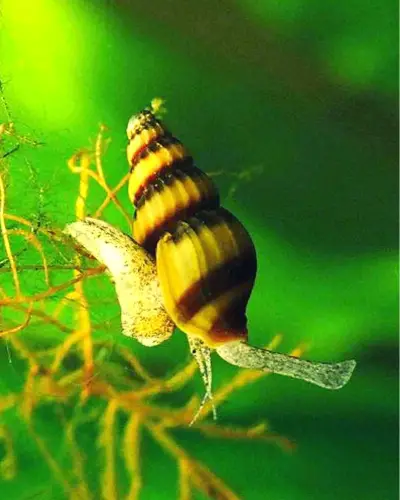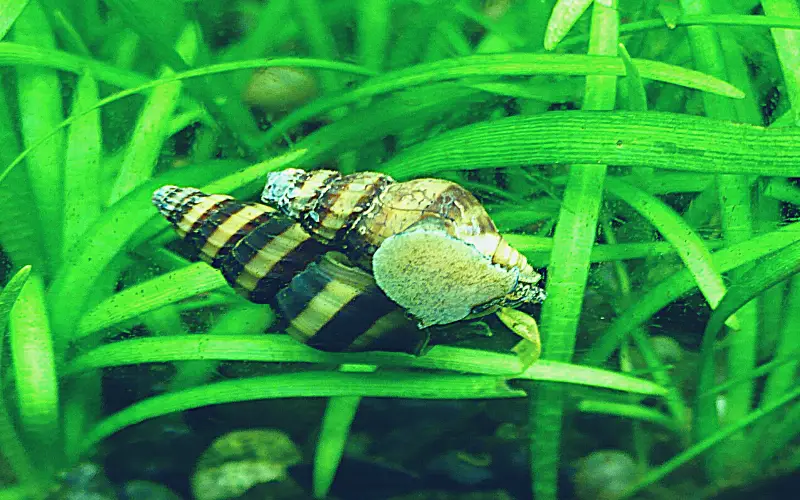How often do assassin snails lay eggs in Aquariums? Assassin snails, also known as Clea Helena, are popular in the aquarium hobby for their ability to control pest snail populations.
These tiny predatory snails are known for their striking appearance and voracious appetite for pest snails such as bladder and Malaysian trumpet snails.
However, many aquarium enthusiasts may wonder how often assassin snails lay eggs in their tanks.

Assassin snails are known to reproduce relatively slowly compared to some other snail species. They are not prolific egg layers like pest snails but can still be produced in aquarium settings under the right conditions.
Assassin snails will lay eggs every few weeks, with each clutch containing a small number of eggs. These eggs are often laid in hidden, secluded areas such as rocks or substrates.
In this article, we will explore the breeding habits of assassin snails and how to care for their eggs in an aquarium setting.
Table of Contents
ToggleHow Often Do Assassin Snails Lay Eggs in Tanks?
How often do assassin snails reproduce? Assassin snails are prolific breeders but don’t lay eggs in large batches. Here’s the breakdown:
- Lay one egg at a time: Unlike other freshwater snails, Southeast Asia snail assassins lay a single egg during mating.
- Frequent laying: They can often mate and lay eggs, with some accounts suggesting they do it almost constantly.
However, some factors can influence how often they lay eggs:
- Food source: Some keepers report increased egg-laying after feeding the snails with meaty foods like bloodworms.
Overall, assassin snails have the potential to lay a significant number of eggs over time, so it’s essential to be aware of their breeding habits if you’re keeping them in an aquarium.
How Many Eggs Do Assassin Snails Lay at a Time?
Assassin snails are not high-volume egg layers. Unlike other snail species, they lay their eggs one at a time.
However, you might see them lay several eggs nearby, which can create the appearance of a clutch. The individual eggs will be encased in a translucent rectangular capsule and attached to hard surfaces in the tank.

They prefer to lay their eggs on hard surfaces such as rocks, glass, or decorations in the tank. The eggs are small and hatch within a few weeks, depending on water parameters and temperatures. The young snails will emerge and begin scavenging for food in the tank.
It is important to note that assassin snails are carnivorous and will eat other snails in the tank, so if you do not want them to reproduce, be sure to keep one in your aquarium.
Additionally, if you want to breed assassin snails, provide them with plenty of hiding spots and food sources to keep them healthy and happy in their small tank size.
Assassin Snail Care and Breeding Tips
Assassin snails are a helpful addition to aquariums with unwanted snail populations, but keeping them happy and thriving requires a specific setup. Here’s what you need to know about assassin snail care and breeding:
Care:
- Habitat: They prefer at least 10 gallons of aquariums with soft, burrowing substrate like sand or gravel. Aim for 2-3 inches of substrate depth.
- Water: They do well in various freshwater conditions, but ideally with a slightly alkaline pH (7.0-8.0) and moderate hardness for shell health. Keep the temperature between 75-80 degrees Fahrenheit and nitrates low with regular water changes. Avoid copper-based treatments, as they are toxic to snails.
- Diet: Assassin snails are carnivores. They primarily feed on other snails, but you can supplement their diet with sinking fish food, bloodworms, or blanched veggies. If there aren’t enough other snails, they might not reproduce.
Breeding:
- Breeding group: Since it’s difficult to tell the sex of assassin snails, purchase a group of at least 5-6 to increase the chances of having both males and females.
- Breeding process: No particular breeding setup is needed. They will lay clutches of eggs on the aquarium glass, decorations, or substrate. The eggs hatch in about three months.
- Feeding the fry: Newly hatched assassin snail offspring are tiny and need infusoria (microscopic food) or finely crushed fish flakes for the first few weeks.
Additional Tips:
- Assassin snails might munch on shrimp or other small invertebrates, so tankmate selection is essential.
- They are peaceful with fish but avoid large or aggressive fish that might eat them.
Good Tank Mates For Assassin Snails In Aquariums
When looking for suitable tankmates for assassin snails, there are a few key things to consider. Ramshorn snails and pond snails are good options as they are tiny snails that assassin snails can easily prey on. Keeping the water conditions stable and checking the water quality regularly is essential.
Plants, driftwood, and pond snails to eat are also essential to keep a good balance in the tank. Additionally, introducing algae eaters such as Otocinclus catfish can help keep algae under control.
Providing plenty of places for smaller snails to hide in, like empty snail shells or egg-laying sites, can also benefit the aquarium ecosystem.
Assassin snails are beneficial tank mates for aquariums with a pest snail problem, but you need to choose their companions carefully because they are predators.
Here are some ideal tank mates for assassin snails:
Peaceful Fish:
- These include community fish that occupy the middle and upper levels of the tank and are too large for the assassin snails to prey on. Examples include neon tetras, Corydoras catfish, Otocinclus catfish, Celestial Danios, Cherry Barbs, Rainbowfish, Pearl Gouramis, and Dwarf Gouramis.
Larger Snails:
- Mystery snails and adult Nerite snails are too giant for assassin snails to eat. However, be cautious if you have a large population of assassin snails, which can sometimes gang up on an enormous snail.
Shrimp (with caution):
- While not ideal, some larger, fast-moving shrimp-like Ghost Shrimp or Amano Shrimp, can be tank mates with assassin snails. However, there’s a chance the assassin snails might eat shrimp fry or weak/molting shrimp.
Tank Mates to Avoid:
- Avoid tank mates that might eat assassin snails, such as loaches, crayfish, cichlids, goldfish, and aggressive fish.
- Small invertebrates like dwarf shrimp and other tiny snails are not suitable tank mates because they’ll likely become food for the assassin snails.
Commonly Asked Questions about Breeding Assassin Snails And Reproduction (FAQs)
How many eggs do an assassin snail lay?
Assassin snail how many eggs can she lay? Assassin snails are single egg layers. They lay one egg at a time but may lay many eggs frequently, especially with a good food source.
How many babies do Asian snails have?
Assassin snails don’t have live babies; they lay eggs in clutches. The exact number of eggs in a clutch can vary.
How To Recognize An Assassin Snail Egg?
Assassin snail eggs are laid singly, not in clusters. Look for tiny, translucent capsules with a yellowish or light brown spot inside on aquarium surfaces. These are likely assassin snail eggs.
How long does it take for assassin snail eggs to hatch?
Assassin snail eggs take about two months to hatch. They are laid singly on planted tank surfaces and turn from yellow to light brown as they develop.
Can a single assassin snail reproduce?
No, a single assassin snail cannot reproduce on its own. They are sexual creatures and require a mate to fertilize their eggs.
How often does a snail lay eggs?
A snail’s egg-laying frequency depends on the species, but many can lay several clutches (up to 6) in a year. Each clutch can hold around 80 eggs!
How long after a snail lays eggs do they hatch?
Snail egg hatch time varies by species, but it typically takes 1-4 weeks. Warmer temperatures speed up hatching, while cooler temps slow it down.
Conclusion
So, how often do assassin snails reproduce? In conclusion, understanding the reproductive habits of assassin snails is crucial for anyone who keeps these fascinating creatures in their aquariums. We’ve explored the intriguing world of assassin snails, delving into their predatory nature and ability to control pest populations. We’ve learned about their unique reproductive strategy, with females laying eggs in small capsules and the potential for rapid population growth if left unchecked.
Aquarists can better manage their numbers and prevent unwanted surprises by knowing how often do assassin snails lay eggs. So, whether you’re a hobbyist or a professional aquarist, keeping an eye on the reproductive habits of assassin snails is essential for maintaining a healthy and balanced aquatic environment.
Recommended Posts
- Do Assassin Snails Eat Snail Eggs: (Shocking Truth Revealed)
- How to Hatch Assassin Snail Eggs in your Aquarium (Solved)
- What Do Snail Eggs Look Like in Aquarium: (Ultimate Guide)
- Identifying Pond Snail Eggs in Aquarium: Comprehensive Guide
- Freshwater Aquarium Snail Eggs on Glass: What You Should Do?
- Assassin Snail Eating 101: A Comprehensive Beginners Guide




